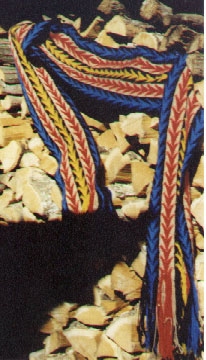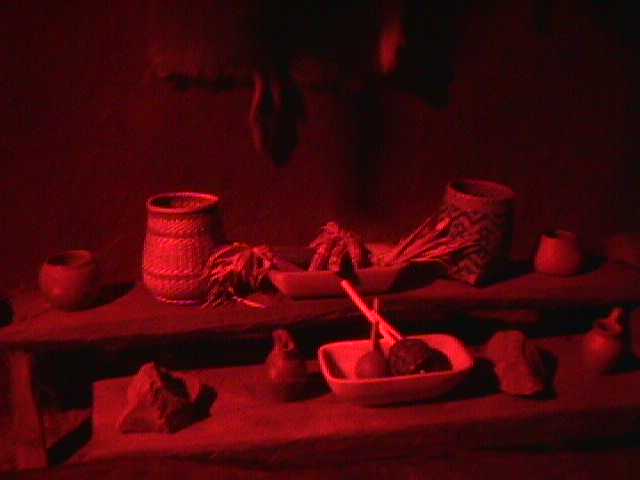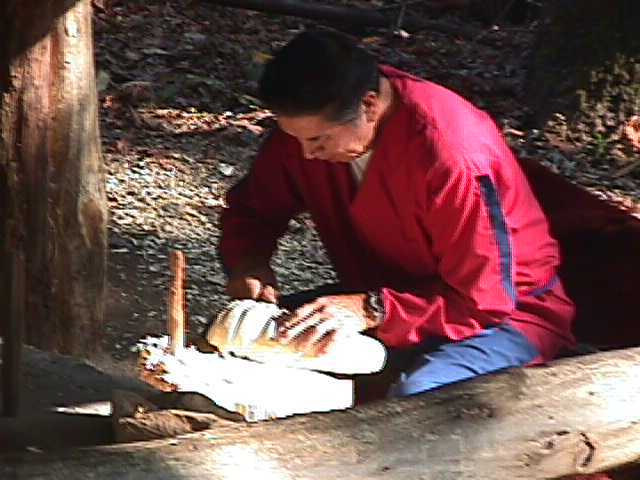
The Cherokee lived in mud huts similar to the picture during the 1700's. It was a very sophisticated style of home, made by standing logs on end and creating a lattice work of twigs and sticks between the logs and then mixing the red clay with water and applying it to the framework. The wall was built up until it was about a foot thick. This type home was cool in summer and warm in winter, much like the stucco utilized in the Southwest. The roof was thatched with layers of branches, twigs, grasses and mud. A vent was created in the roof for smoke from the fire to escape. The windows were covered with a latticework of river cane strips. There were two types of cane, that which grew by the water's edge, called river cane and that which grew in the mountains, called mountain cane. A hut like this was used for the sweat lodge on a larger scale. It was used for meetings and to house the sick and elderly during the cold months. Another mud hut was often built beside the main house, and used to store or smoke food.

Our ancestors made simple pottery for everyday use. They made tools to etch designs in the pots. If a pot was low fired it retained most of its red clay coloring, if high fired it turned black. Few craftsmen make pots today, mostly for sale to the tourists.

Basketmaking is a highly developed skill and craft still utilized today. The designs had special meaning at one time but are lost to us today. Basket makers today make both the single and double woven baskets to sell to the tourists. They were made of both river and mountain cane.

Fingerweaving is a art still done today using available yarns. Originally this craft from done using hemp and natural fibers. Used to make belts and garters in traditional colors as well as modern spectrum. Red and black sometimes with white belts were made by women as wedding gifts to their spouses. Sometimes clan colors were used as well.

This is a view inside the store house hut.

Designs changed a bit after the White man's invasion and the log cabin as you see it here was used. The Cherokee never lived in Teepees as depicted in movies and books down through the decades, they always lived in houses. This house became more prevalent during the 1800's and is the forebearer of modern log cabins. The indigenous peoples who took in the invaders taught them how to survive in this land.

The blow gun is made with river or mountain cane. Implements were made early on of iron and used heated to burn out the center of the tubing which measures from 3-5 feet in length. The darts are made of sticks of wood carved to measure about 6-10 inches and tuffs from hemp plants, secured with hemp string. The accuracy is amazing.

Carving is a craft brought down through the ages. At one time masks were made with whatever was available, a piece of bark, a piece of animal hide and decorated with grasses, twigs, horse hair, animal pieces and so on. The mask was used during certain ceremonies and story time with children. In some instances it was thought to scare away the evil beings.

The ceremonial grounds of the Cherokee were square and very similar to the one pictured. Because our peoples lived by waterways, sand and earth were piled up to form the square, we did not use the straw bales utilized in modern day PowWows. We also dance counterclockwise as opposed to clockwise as the intertribal PowWows do. We used two types of drums, the water drum and the hollow drum. Dances started when the medicine keeper felt it was right and ended when he/she felt it was right. Sometimes dances would last until dawn. Why do we dance? Because we can...